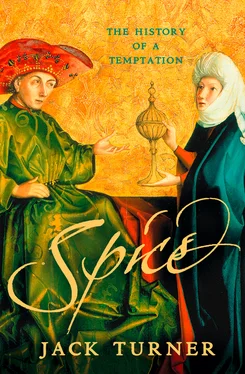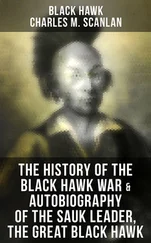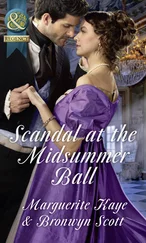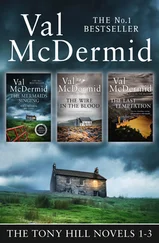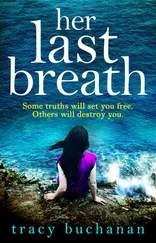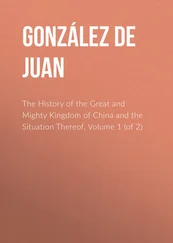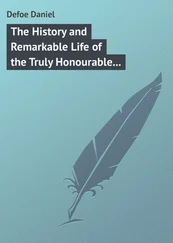SPICE
The History of a Temptation
JACK TURNER
To Helena
Cover
Title Page
Dedication
Maps
Spices in The Age of Discovery
Columbus’s Conception of The Atlantic And The Indies
Vasco Da Gama’s Route, 1497–1499
Route of Magellan’s Circumnavigation, 1519–1522
Introduction: The Idea of Spice
Part I: The Spice Race
1: The Spice-Seekers
The Taste that Lavinched a Thousand Ships
Christians and Spices
Debate and Stryfe Betwene the Spanyardes and Portugales
The Scent of Paradise
Part II: Palate
2: Ancient Appetites
The Aromanauts
Of Spiced Parrot and Stuffed Dormice
Spice for Trimalchio
Decline, Fall, Survival
3: Medieval Europe
Flavours of Cockayne
Salt, Maggots and Rot?
The Regicidal Lamprey and the Deadly Beaver
Keeping up with the Percys
Part III: Body
4: The Spice of Life
The Pharaoh’s Nose
Abbot Eberhard’s Complaint
Pox, Pestilence and Pomanders
5: The Spice of Love
Whan Tendre Youthe Hath Wedded Stoupyng Age
Hot Stuff
Spice Girls
Afterword, or How to Make a Small Penis Splendid
Part IV: Spirit
6: Food of the Gods
Holy Smoke
God’s Nostrils
Odours of Sanctity
Old Age, New Age
7: Some Like it Bland
St Bernard’s Family Tiff
Filthy Lucre
Epilogue: The End of the Spice Age
Sources and Bibliography
Index
Acknowledgements
About the Author
Praise
Copyright
About the Publisher
Spices in The Age of Discovery
Columbus’s Conception of The Atlantic And The Indies
Vasco Da Gama’s Route, 1497–1499
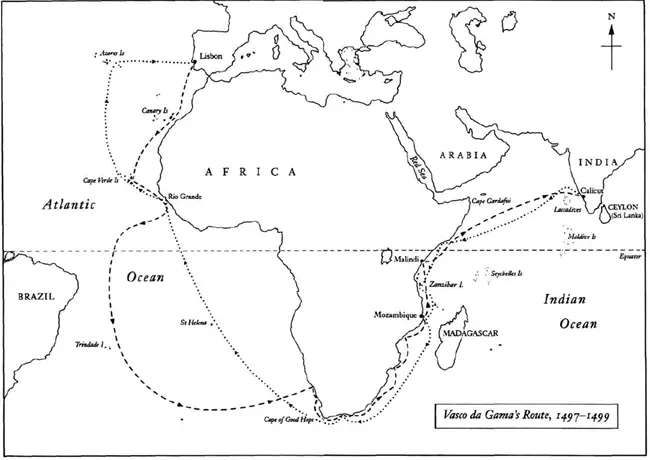
Route of Magellan’s Circumnavigation, 1519–1522
INTRODUCTION The Idea of Spice
A certain Christopher Columbus, a Genoese, proposed to the Catholic King and Queen, Ferdinand and Isabella, to discover the islands which touch the Indies, by sailing from the western extremity of this country. He asked for ships and whatever was necessary to navigation, promising not only to propagate the Christian religion, but also certainly to bring back pearls, spices and gold beyond anything ever imagined.
Peter Martyr, De Orbe Novo, 1530
One day at Aldgate Primary School, after the dinosaurs and the pyramids, we did the Age of Discovery. Our teacher produced a large, illustrated map, showing the great arcs traced across the globe by Columbus and his fellow pioneers, sailing tubby galleons through seas where narwhals cavorted, whales spouted and jowly cherub heads puffed cotton-wool clouds. Parrots flew overhead while jaunty, armour-clad gents negotiated on the beaches of the new-found lands, asking the natives if they would like to convert to Christianity and whether by chance they had any spice.
Neither request struck us ten-year-olds as terribly reasonable: we were a pagan, pizza-eating lot. As for the spices, our teacher explained that medieval Europeans were afflicted with truly appalling food, necessitating huge quantities of pepper, ginger and cinnamon to disguise the tastes of salt and old and rotting meat – which, being medieval, they then shovelled in. And who were we to disagree? It made a lot of sense, particularly relative to the generally perplexing matter of schoolboy history, whether it was frostbitten Norwegians dragging their sleds to the South Pole, explorers dying of thirst in the quest for non-existent seas and rivers, or knights taking the cross to capture the Holy Sepulchre from the infidel – all, from a schoolboy’s perspective, strangely perverse and pointless pursuits. The discoverers were somehow more intelligible, more human: our food at school was lousy, but theirs was so dismal that they sailed right around the world for relief. And to an Australian ten-year-old this was not only plausible but highly relevant: so this was why we were colonised by the English.
There was some truth in my potted ten-year-old perspective, albeit radically streamlined. The first Englishmen in Asia were indeed looking for spices, as were the Iberian discoverers before them (whereas Australia, not having any spice, was left till later). Spice was a catalyst of discovery and, by extension – in that much-abused phrase of the popular historian – the reshaping of the world. The Asian empires of Portugal, England and the Netherlands might be said with only a little exaggeration to have sprouted from a quest for cinnamon, cloves, pepper, nutmeg and mace, and something similar was true of the Americas. It is true that the hunger for spices galvanised an extraordinary, unparalleled outpouring of energies, both at the birth of the modern world and for centuries, even millennia, before. For the sake of spices, fortunes were made and lost, empires built and destroyed, and even a new world discovered. For thousands of years this was an appetite that spanned the planet and, in doing so, transformed it.
And yet to modern eyes it might seem a mystery that spices should ever have exerted such a powerful attraction, however bad the food: mildly exotic condiments, we might think, but hardly worth the fuss. In an age that pours its commercial energies into such unpoetical ends as arms, oil, ore, tourism and drugs, that such energies were devoted to the quest for anything quite so quaintly insignificant as spice must strike us as mystifying indeed.
In another sense, however, the attraction of spices is still with us. Let your remote control lead you far and wide enough through the nether regions of American television and sooner or later, amid the chat shows and the monster truck racing, you will come across a soft porn channel by the name of Spice. Any possible confusion about its contents – I first took it for a cooking channel – is soon dispelled by advertisements for a cast of pneumatic-chested sirens, served up and devoured by rippling, oiled hunks. The name was chosen, I suppose, to strike a suggestive note: to hint of exotic, forbidden delights, while at the same time forewarning of strong flavours – sultry scenes in the suburbs and breathless encounters poolside. A little will titillate, too much and your senses are overwhelmed.
Which is probably true enough. But while the Spice channel might suggest something about the creative proclivities of American television, the reader may think it has little to tell us about spice. Yet in fact the erotic associations of the word are part of an old tradition. Spices have always been sexy – and it would seem they still are, at least in TV-land. Spices have an ancient aphrodisiac reputation, of which the word’s erotic overtones are but the faint, figurative residue. Besides the Spice channel, these associations have resonated with many others, among them no less an authority on the topic than Barbara Cartland, the author of more than seven hundred romantic novels and the aphrodisiac cookbook Food for Love, the preface to which promises to bring ‘spice into your life!’ Long before the invention of television or the romantic novelist there was the Song of Songs, with its lyrical evocation of the loved one as ‘an orchard of pomegranates with all choicest fruits, henna with nard, nard and saffron, calamus and cinnamon, with all trees of frankincense, myrrh and aloes, with all chief spices …’. * Consciously or otherwise, in linking spices and love Cartland partook of a literary tradition reaching as far back in time as ancient Palestine.
Читать дальше
